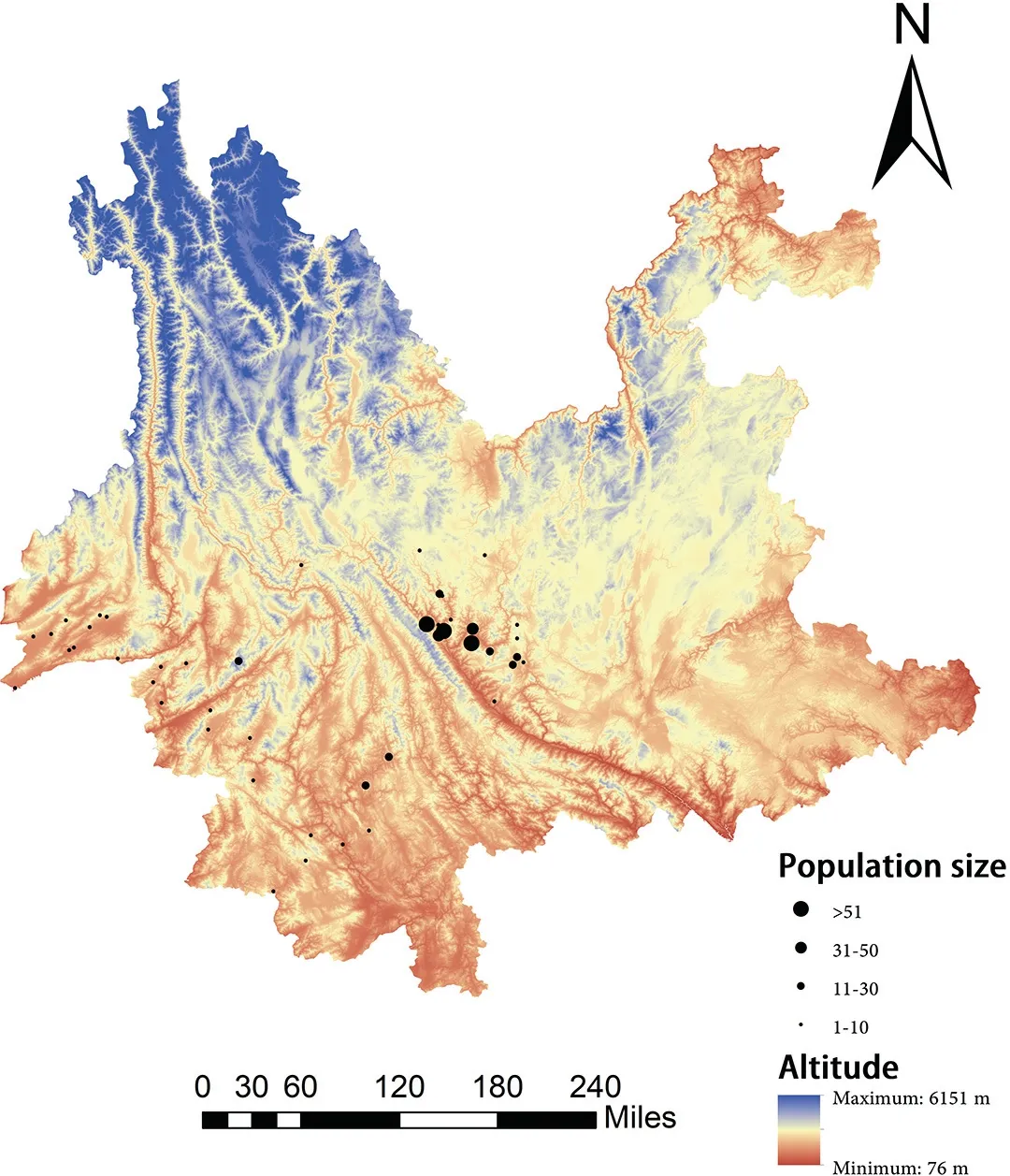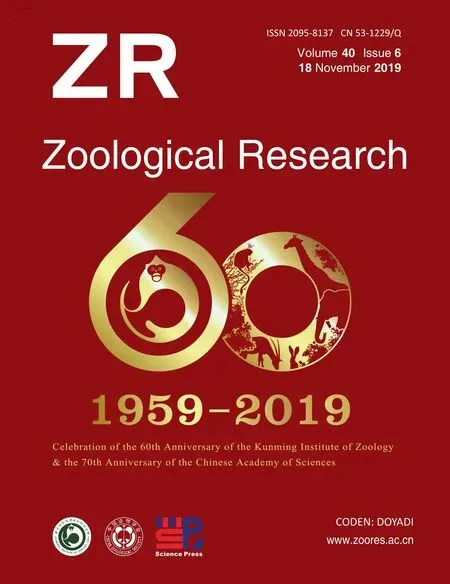Ongoing green peafowl protection in China
DEAR EDITOR,The green peafowl (Pavo muticus) is one of the most threatened pheasants in the world. In China, it is widely appreciated for its beauty as well as historical and cultural value, but current populations number less than 500 individuals. Recently, Tang and colleagues reported in Science that the green peafowl is likely to become extinct due to the construction of the Jiasajiang Level 1 Hydropower Station within the Red River Upstream District(RRUD)and thus called for a stop to this project (Tang et al., 2019).According to our recent surveys,however,this species is still extant in 22 counties of Yunnan Province, China, among which,only two within the RRUD have been predicted to be affected by floods from the hydropower station.Therefore,the conclusion that the species will likely go extinct in China upon completion of the dam is unwarranted.In fact,construction of the Jiasajiang Level 1 Hydropower Station was stopped in August 2017. The main challenge for green peafowl conservation is that over 65%of the population occurs outside of protected reserves in China. Fortunately, the Chinese government has adopted an Ecological Redline (ERL)strategy to achieve ecological civilization plans,thus bringing new hope to the conservation of green peafowls both inside and outside of protected reserves.As a top conservation priority for China, the government is fully committed to conserving this peafowl.
The green peafowl is one of the most threatened pheasants in the world and is currently listed as Endangered on the International Union for the Conservation of Nature(IUCN)Red List of Threatened Species (BirdLife International, 2016).Despites its aesthetic,cultural,and historical value in China,recent comprehensive surveys indicate that the Chinese green peafowl population currently numbers less than 500 individuals(Kong et al.,2018).
Earlier this year,Tang et al.(2019)reported that the green peafowl is likely to become extinct due to the construction of the Jiasajiang Level 1 Hydropower Station within the RRUD,and therefore called for the project to be ceased.They also proposed that additional conservation efforts should be considered for this endangered species, such as an immediate ecological impact re-evaluation, expansion of nature reserves,and increasing number of patrols.As the main green peafowl research team in China (Ornithology Group of the Kunming Institute of Zoology,Chinese Academy of Sciences), we have conducted several green peafowl surveys,including two comprehensive surveys in the 1990s(Wen et al.,1995)and 2014-2018(Kong et al.,2018),to clarify the status and trends of this species in China. In addition,for the past five years,we have specifically focused on the population dynamics of the green peafowl in the entire RRUD as well as its behavioral ecology and impacts of human disturbance in Konglonghe Reserve within the RRUD.Following the assertions of Tang et al.(2019),we would like to clarify several points.
Tang et al.(2019)stated that the RRUD is China's last green peafowl habitat.While it is undoubtedly true that the green peafowl has experienced a sharp range contraction(~60%)in the past three decades(Kong et al.,2018;Wen et al.,1995),our recently published surveys(e.g.,Kong et al.,2018),as cited in Tang et al.(2019),found this species to be extant in 22 counties of Yunnan Province, China.Among these 22 counties,just six fall within the RRUD(Kong et al.,2018)(Figure 1)and only two(Xinping and Shuangbai)are predicted to be affected by floods emanating from the hydropower station construction (CPCGKSDIC, 2014).Therefore,the conclusion that the species will likely go extinct in China upon completion of the dam is unwarranted.
Nevertheless, given that large infrastructure projects are potentially damaging to biodiversity(Johnson et al.,2017),we agree with Tang and colleagues that work on the Jiasajiang Level 1 Hydropower Station should stop until assessments are complete.Indeed,due to concerns raised by conservation stakeholders in China on the plight of the green peafowl within the RRUD,construction of the Jiasajiang Level 1 Hydropower Station was stopped in August 2017.At the same time,other projects under construction within the area,including a silver mine,second hydropower station,and proposed expressway,have ceased or been cancelled.

Figure 1 Distribution sites and population size of green peafowl in Yunnan,China
In addition to infrastructure projects, habitat conversion,poisoning,and poaching are also major threats affecting the survival of the green peafowl in China(Kong et al.,2018).Our surveys in 2018 showed that over 65%of the green peafowl population occurs outside protected reserves in China,making this species even more vulnerable to the aforementioned threats.
However, China's ambitious Ecological Civilization Plan(UNEP,2016;Xiao&Zhao,2017)brings new hope for the conservation of the green peafowl and the other threatened species and ecosystems in the country. Since late 2012,environmental protection has become the core element in Chinese governmental work.In 2017,for the first time,senior officials in Gansu Province,Northwest China,were punished over environmental violations in the Qilian Mountains National Nature Reserve (Xinhua, 2017). To achieve an ecological civilization, the Chinese government has adopted an Ecological Redline (ERL) strategy. The ERL refers to the strictly controlled and legally drawn boundaries for key areas of ecological functions or ecological sensitivity(UNEP,2016).These ERL areas are now formally protected by provisions within China's newly revised Environmental Protection Law of 2015(Bai et al.,2016).Fortunately,the ERL zones in Yunnan Province,demarcated and formally announced on 29 June 2018(The People's Government of Yunnan Province,2018),cover the entire distribution range of the green peafowl population in China.Most green peafowl habitats inside and outside protected reserves,including those within the RRUD,are now incorporated into the ERL of Yunnan. Therefore,according to the Chinese Environmental Protection Law,it will be impossible to commence construction of the Jiasajiang Level 1 Hydropower Station or other infrastructural projects.This will further enhance protection of the green peafowl,especially for populations outside of protected reserves within the RRUD.
In addition to existing efforts geared toward conserving the endangered green peafowl in China, there is an ongoing program to include additional rangers and camera traps to monitor the population status and dynamics as well as current and potential threats of this species.Furthermore,as a top conservation priority in China, the government is fully committed to conserving this peafowl in collaboration with research scientists,NGOs,and local communities living in close proximity.
COMPETING INTERESTS
The authors declare that they have no competing interests.
AUTHORS'CONTRIBUTIONS
X.J.Y.and F.W.designed the study.X.J.Y.,F.W.,D.J.K.,P.F.S.,J.W.,and G.Y.L.supervised the analyses and wrote the manuscript.F.W.,D.J.K.,P.F.S.,J.W.,and G.N.K.revised the manuscript.All authors read and approved the final version of the manuscript.
- Zoological Research的其它文章
- Diversity scaling of human vaginal microbial communities
- Direct sunlight exposure reduces hair cortisol levels in rhesus monkeys(Macaca mulatta)
- First record of the ferret-badger Melogale cucphuongensis Nadler et al.,2011(Carnivora:Mustelidae),with description of a new subspecies,in southeastern China
- A new species of the genus Xenophrys(Anura:Megophryidae)from northern Thailand
- A new species of the genus Raorchestes(Anura:Rhacophoridae)from Yunnan Province,China
- Sinocyclocheilus sanxiaensis,a new blind fish from the Three Gorges of Yangtze River provides insights into speciation of Chinese cavefish

